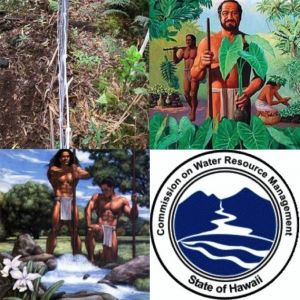Forecasting climate and land use/cover change impacts on freshwater ecosystem services in Maui through integration of hydrological and participatory models

Climate and land use/cover changes are expected to have significant impacts on freshwater resources. We hypothesize that ecosystem services-based integrated modeling will increase the adaptive capacity of decision-makers. Integrated modeling couples natural and social systems to better understand how humans influence and are influenced by biophysical changes. An ecosystem services integrated model translates biophysical outcomes into benefits that are valuable to humans. Adapting to future hydrological conditions requires decision-makers to identify actions that will maintain (or minimize the loss of) these valuable ecosystem goods and services.
Our goal is to integrate a watershed-scale hydrological model and a local knowledge-based participatory model to predict the management policy responses of different stakeholder groups who hold diverse values for freshwater ecosystem services. The approach will evaluate stakeholders’ perceptions of the local freshwater system in Maui under the existing and future environmental conditions, as well as policies related to stream flow standards and water transfers. We aim to understand how stakeholders perceive and value freshwater, how perceptions differ between stakeholder groups, and how future environmental and policy changes will affect the stakeholder groups.
Five methodological steps will achieve our goal and test our hypothesis: 1) defining climate and land use change scenarios; 2) modeling freshwater changes under the scenarios using a hydrological model; 3) describing relationships between watershed dynamics and management policy using a participatory model; 4) developing participatory model scenarios; and 5) using scenario results to inform management strategies.
Accordingly, we have collected data on environmental drivers, have performed preliminary hydrological modeling in windward watersheds (Wahikuli, Honokōwai, Kahana, Honokahua and Honolua), and will continue to model in a leeward watershed (‘Īao) in Maui. Next, to prioritize and model local freshwater ecosystem services, we are planning to interview people within at least four different stakeholder groups (conservationists, agriculturalists, cultural practitioners, and water resources managers).
Some expected outcomes include a stakeholder-specific representation of the hydrological, ecological, and social freshwater system, and an analysis of possible policy responses under climate and land use scenarios. Our approach will enhance managers’ understanding of the potential impacts that global climate change, regional land use/cover change, and management/policy response will have on the coupled hydrological-ecological system, as well as the ecosystem goods and services different stakeholders value.
PROJECT DETAILS
FUNDED:
FY2015
PI:
Christopher Lepczyk
Dept. Natural Resources & Environmental Mgmt, UH Mānoa
Co-PI:
Kirsten Oleson
NREM, UH Mānoa
Co-Is:
Steven Gray
NREM, UH Mānoa
Yin-Phan Tsang
NREM, UH Mānoa

